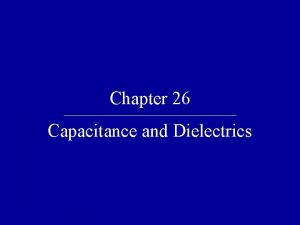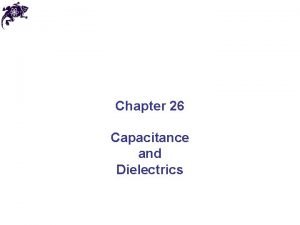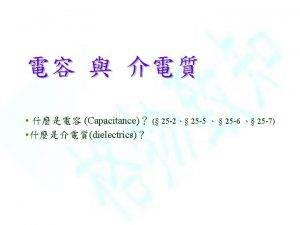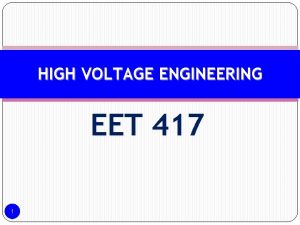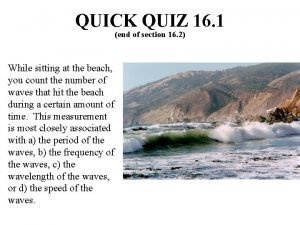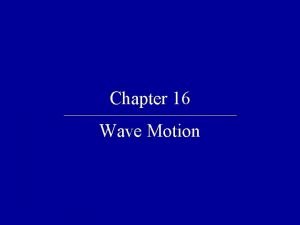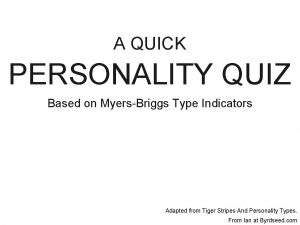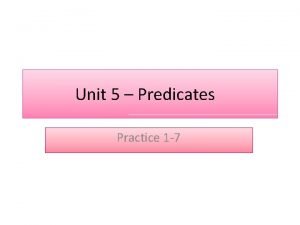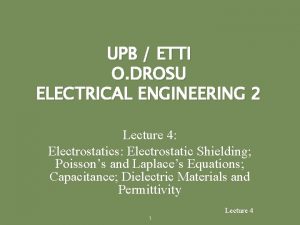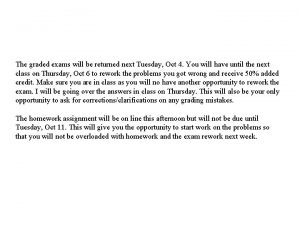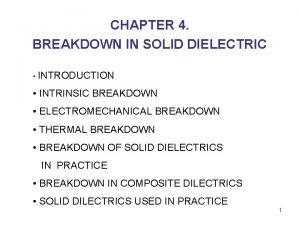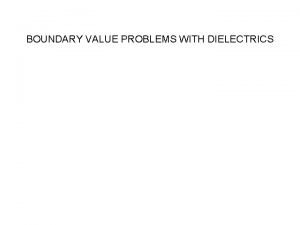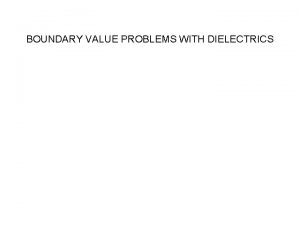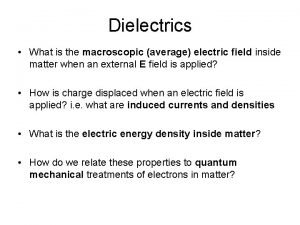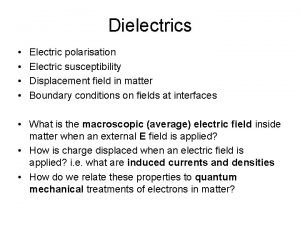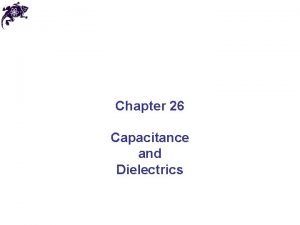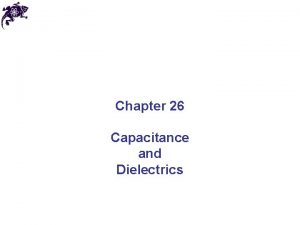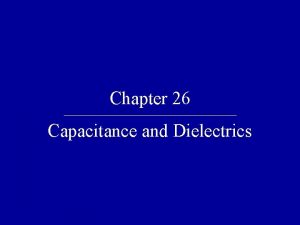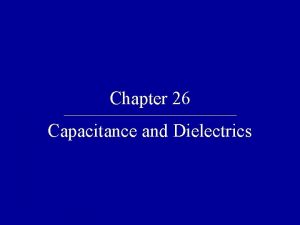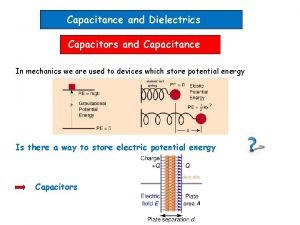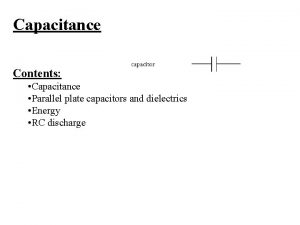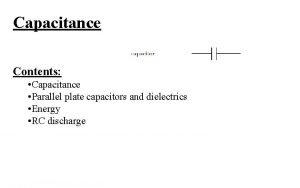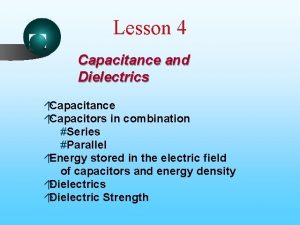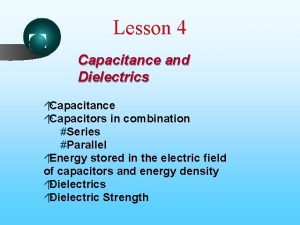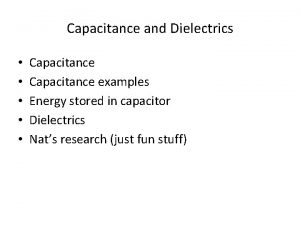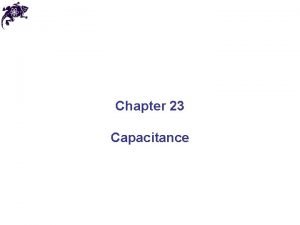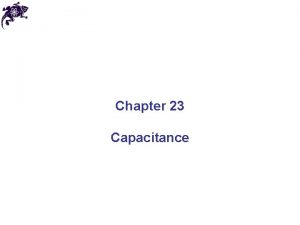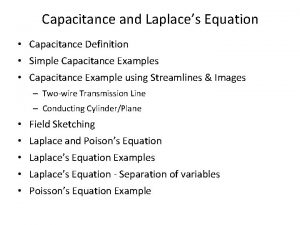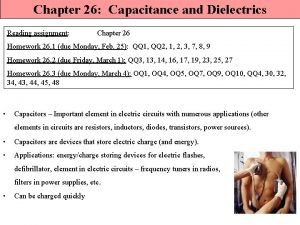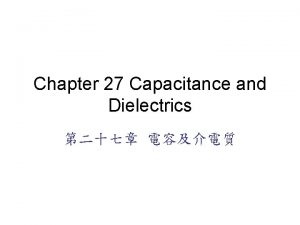Chapter 26 Capacitance and Dielectrics Quick Quiz 26



















- Slides: 19

Chapter 26 Capacitance and Dielectrics

Quick Quiz 26. 1 A capacitor stores charge Q at a potential difference ∆V. If the voltage applied by a battery to the capacitor is doubled to 2 ∆V: (a) the capacitance falls to half its initial value and the charge remains the same (b) the capacitance and the charge both fall to half their initial values (c) the capacitance and the charge both double (d) the capacitance remains the same and the charge doubles

Quick Quiz 26. 1 Answer: (d). The capacitance is a property of the physical system and does not vary with applied voltage. According to Equation 26. 1, if the voltage is doubled, the charge is doubled.

Quick Quiz 26. 2 Many computer keyboard buttons are constructed of capacitors, as shown in the figure below. When a key is pushed down, the soft insulator between the movable plate and the fixed plate is compressed. When the key is pressed, the capacitance (a) increases (b) decreases (c) changes in a way that we cannot determine because the complicated electric circuit connected to the keyboard button may cause a change in ∆V.

Quick Quiz 26. 2 Answer: (a). When the key is pressed, the plate separation is decreased and the capacitance increases. Capacitance depends only on how a capacitor is constructed and not on the external circuit.

Quick Quiz 26. 3 Two capacitors are identical. They can be connected in series or in parallel. If you want the smallest equivalent capacitance for the combination, you should connect them in (a) series (b) parallel (c) Either combination has the same capacitance.

Quick Quiz 26. 3 Answer: (a). When connecting capacitors in series, the inverses of the capacitances add, resulting in a smaller overall equivalent capacitance.

Quick Quiz 26. 4 Consider the two capacitors in question 3 again. Each capacitor is charged to a voltage of 10 V. If you want the largest combined potential difference across the combination, you should connect them in (a) series (b) parallel (c) Either combination has the same potential difference.

Quick Quiz 26. 4 Answer: (a). When capacitors are connected in series, the voltages add, for a total of 20 V in this case. If they are combined in parallel, the voltage across the combination is still 10 V.

Quick Quiz 26. 5 You have three capacitors and a battery. In which of the following combinations of the three capacitors will the maximum possible energy be stored when the combination is attached to the battery? (a) series (b) parallel (c) Both combinations will store the same amount of energy.

Quick Quiz 26. 5 Answer: (b). For a given voltage, the energy stored in a capacitor is proportional to C: U = C(∆V)2/2. Thus, you want to maximize the equivalent capacitance. You do this by connecting the three capacitors in parallel, so that the capacitances add.

Quick Quiz 26. 6 You charge a parallel-plate capacitor, remove it from the battery, and prevent the wires connected to the plates from touching each other. When you pull the plates apart to a larger separation, do the following quantities increase, decrease, or stay the same? (a) C; (b) Q; (c) E between the plates; (d) ∆V ; (e) energy stored in the capacitor.

Quick Quiz 26. 6 Answer: (a) C decreases (Eq. 26. 3). (b) Q stays the same because there is no place for the charge to flow. (c) E remains constant (see Eq. 24. 8 and the paragraph following it). (d) ∆V increases because ∆V = Q/C, Q is constant (part b), and C decreases (part a). (e) The energy stored in the capacitor is proportional to both Q and ∆V (Eq. 26. 11) and thus increases. The additional energy comes from the work you do in pulling the two plates apart.

Quick Quiz 26. 7 Repeat Quick Quiz 26. 6, but this time answer the questions for the situation in which the battery remains connected to the capacitor while you pull the plates apart.

Quick Quiz 26. 7 Answer: (a) C decreases (Eq. 26. 3). (b) Q decreases. The battery supplies a constant potential difference ∆V; thus, charge must flow out of the capacitor if C = Q / ∆V is to decrease. (c) E decreases because the charge density on the plates decreases. (d) ∆V remains constant because of the presence of the battery. (e) The energy stored in the capacitor decreases (Eq. 26. 11).

Quick Quiz 26. 8 If you have ever tried to hang a picture or a mirror, you know it can be difficult to locate a wooden stud in which to anchor your nail or screw. A carpenter’s stud-finder is basically a capacitor with its plates arranged side by side instead of facing one another, as shown in the figure below. When the device is moved over a stud, the capacitance will: (a) increase (b) decrease

Quick Quiz 26. 8 Answer: (a). The dielectric constant of wood (and of all other insulating materials, for that matter) is greater than 1; therefore, the capacitance increases (Eq. 26. 14). This increase is sensed by the stud-finder's special circuitry, which causes an indicator on the device to light up.

Quick Quiz 26. 9 A fully charged parallel-plate capacitor remains connected to a battery while you slide a dielectric between the plates. Do the following quantities increase, decrease, or stay the same? (a) C; (b) Q; (c) E between the plates; (d) ∆V.

Quick Quiz 26. 9 Answer: (a) C increases (Eq. 26. 14). (b) Q increases. Because the battery maintains a constant ∆V, Q must increase if C increases. (c) E between the plates remains constant because ∆V = Ed and neither ∆V nor d changes. The electric field due to the charges on the plates increases because more charge has flowed onto the plates. The induced surface charges on the dielectric create a field that opposes the increase in the field caused by the greater number of charges on the plates (see Section 26. 7). (d) The battery maintains a constant ∆V.
 Capacitance and dielectrics quiz
Capacitance and dielectrics quiz Capacitance and dielectrics
Capacitance and dielectrics Quick find algorithm
Quick find algorithm 1.7.6 - quick check: frost quick check
1.7.6 - quick check: frost quick check What are polar and nonpolar dielectrics
What are polar and nonpolar dielectrics Example of pure liquid dielectric
Example of pure liquid dielectric Treeing and tracking in solid dielectrics
Treeing and tracking in solid dielectrics Section quiz 16-1
Section quiz 16-1 Quick quiz 16 answers
Quick quiz 16 answers Quick personality quiz
Quick personality quiz Subjects and predicates quiz
Subjects and predicates quiz Gauss law in dielectrics
Gauss law in dielectrics Derive gauss law in dielectric medium
Derive gauss law in dielectric medium Lossy medium means
Lossy medium means Dielectric conductor
Dielectric conductor Solid dielectric breakdown
Solid dielectric breakdown Boundary
Boundary Boundary value problems with dielectrics
Boundary value problems with dielectrics Polarisation
Polarisation Electric susceptibility
Electric susceptibility
